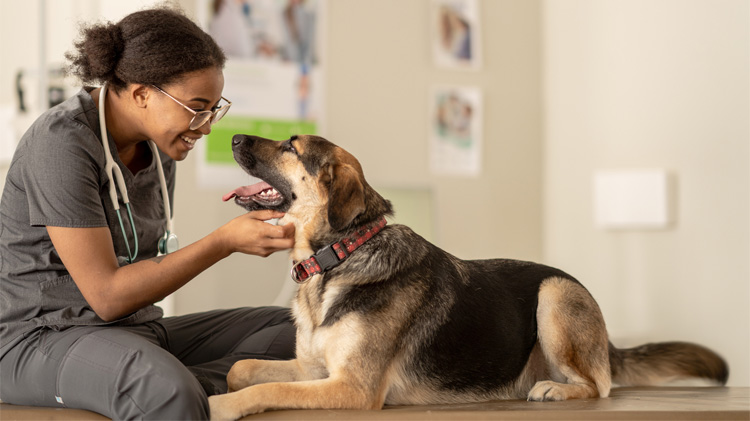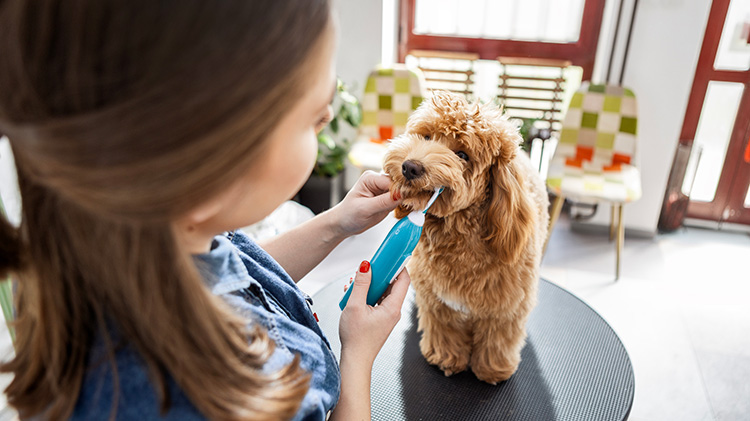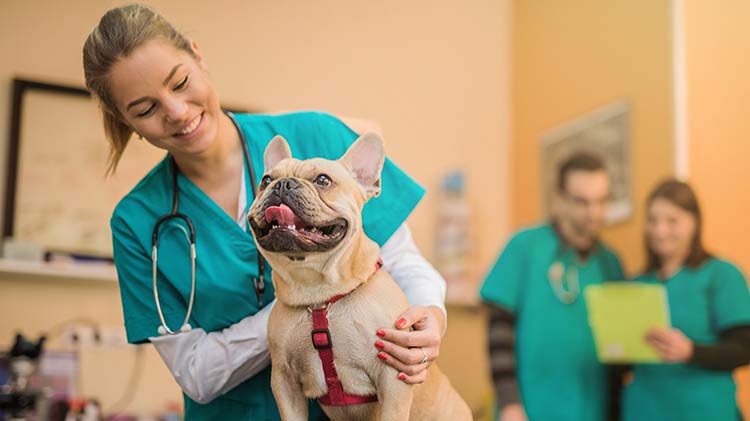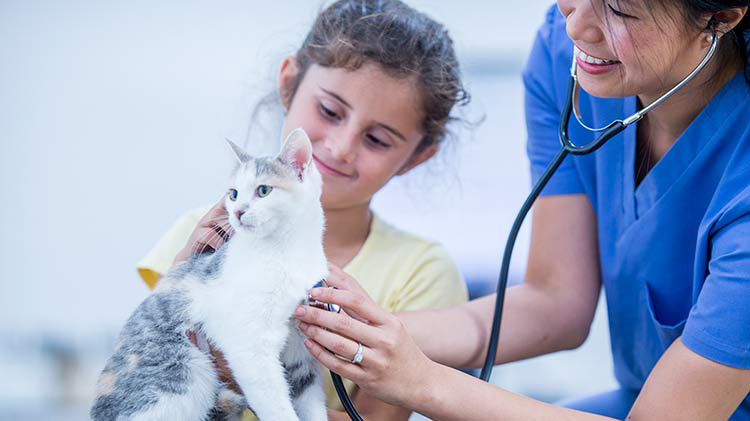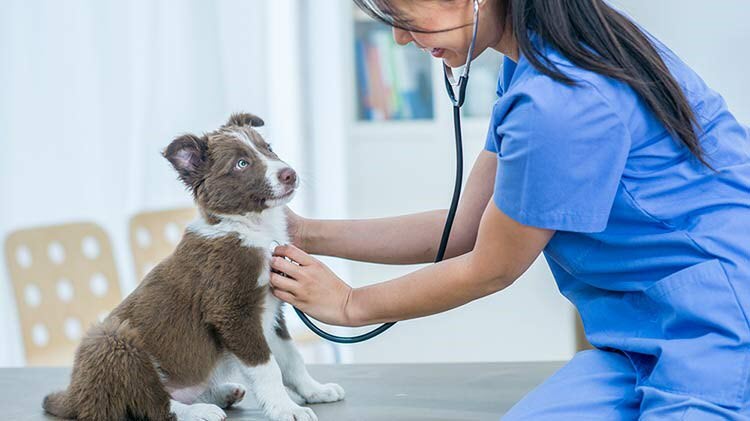A guide to dental care for pets
Consider this guide to help take care of your dog or cat’s dental health.
Did you know February is National Pet Dental Health Month? While the importance of regular veterinary checkups and vaccinations is well-known, pet dental care is an aspect that often takes a backseat. As responsible pet owners, it’s our job to care about their overall wellbeing — and that includes their dental health.
Healthy teeth and gums are essential to your pet’s overall health. Almost 90% of pets over the age of 3 have some form of periodontal disease, and poor dental health can lead to a range of issues, from bad breath and tooth loss, to more severe problems like heart and kidney disease. So how can you help keep your cat or dog’s teeth clean and healthy? Consider these 8 pet dental care tips!
8 essential dog and cat dental care tips
1. Talk with your veterinarian about pet dental care
Every pet is different, so your veterinarian can provide individualized guidance on how to maintain your pet’s oral health between checkups. Depending on whether your pet receives regular brushing, they may recommend professional cleanings once or twice a year in addition to regular dental exams.
Smaller dog breeds and cats are more likely to develop dental problems. If your pet is at a higher risk for dental disease, your veterinarian may recommend more frequent cleanings and exams, as well as additional preventive measures.
2. Know the signs of pet dental problems
Periodontal disease, also known as gum disease, is usually caused by bacteria and plaque buildup. As the disease progresses, the gums and underlying bone that support the teeth begin to rot and decay, eventually leading to tooth loss. In severe cases, periodontal disease can infect other areas of your pet’s body, including vital organs like their heart, kidney and liver.
Unfortunately, periodontal disease isn’t easily visible to the naked eye because it begins and exists under the gumline. By the time there are obvious signs of periodontal disease, there may already be significant damage. If you spot any of the below signs, don’t wait to schedule a dental appointment with your veterinarian:
- Halitosis (bad breath)
- Difficulty chewing
- Excessive drooling
- Swollen, red, bleeding or receding gums
- Loose or discolored teeth
- Changes in eating and chewing habits
- Bloody saliva
Bad breath is one of the most common signs of dental disease, but your pet’s stomach, liver or kidney could also be the culprit. If your pet’s breath consistently smells bad, give your veterinarian a call.
3. Start at-home dental care early (but not too early)
The sooner you introduce at-home dental care to your pet, the better! You can safely start brushing your pet’s teeth once they have a full set of permanent adult teeth, which usually happens by the time they’re 6 months old.
It’s never too late to start prioritizing your pet’s oral health, but starting early can help make the process much smoother for both you and your pet.
4. Learn how to effectively brush your pet’s teeth
Regular brushing is the best way to help prevent bacteria and plaque buildup. Daily brushing is best! If your pet isn’t accustomed to at-home dental care, introduce it slowly and gradually. Start by gently touching their gums and teeth with your finger before progressing to a pet-friendly toothbrush and use lots of praise and treats to help make it a positive experience.
You can also introduce dental care to your pet by dabbing some pet-safe toothpaste onto their teeth. Even without brushing, toothpaste is capable of killing bacteria in your pet’s mouth. Just remember to never brush your pet’s teeth with human toothpaste, as it can contain ingredients that are toxic to pets.
Regular dental care not only helps prevent pain and discomfort, but may also contribute to a longer, healthier life for your pet.
5. Be patient and consistent
Introducing your pet to a new dental routine requires patience and consistency. Most pets are initially resistant and uncomfortable with the sensation of having their teeth brushed, so give your pet time to acclimate to this new experience. With practice and consistency, brushing your pet’s teeth should get easier.
If brushing your pet’s teeth isn’t getting any easier, consult your veterinarian. They can typically recommend new techniques and provide alternatives to brushing your pet’s teeth the traditional way. Some pets are simply more sensitive when it comes to their mouth, while others might have a more anxious temperament.
6. Choose the right chew toys for your pet
Certain toys and chews, even those sold in a pet store, aren’t necessarily safe for pets. Anything that’s too hard could damage your pet’s teeth, and products made of stiff plastic are also more likely to shatter. Those sharp fragments pose serious risks when swallowed, including choking, internal bleeding and intestinal blockages. Soft and rubber toys don’t break as easily, so choose toys that are more bendy and malleable.
7. Supplement regular brushing with dental chews and products
While nothing is as effective as regular brushing, there are quite a few products that can help promote good dental hygiene for dogs and cats. Chewing can help naturally clean your pet’s teeth and get rid of plaque buildup. For dogs, all-natural chews like bully sticks are great at maintaining healthy dog teeth. Cats generally don’t chew on toys the same way dogs do, so look for chew toys that you can stuff or infuse with catnip!
If you’re unable to regularly brush your pet’s teeth, consider using dental wipes, treats, chews, diets and water additives specifically designed to fight bacteria and reduce plaque buildup. As always, speak with your veterinarian first before adding something new to your pet’s dental care routine.
Small pets are more likely to develop dental problems, so consider enhancing your pet’s dental care routine with additional tactics and products. When it comes to pet dental disease, prevention is better and more effective than any treatment!
8. Invest in pet dental insurance
Pets with healthy teeth and gums are still susceptible to unexpected dental injuries and illnesses. As stated above, periodontal disease isn’t easily detectable and can lead to more serious conditions like heart and kidney disease. But with Trupanion pet insurance your pet can get the dental care they need, when they need it.
Cost varies depending on the particular pet and their risks, and getting a pet insurance quote can give you a better idea of what to expect. It’s worth noting that, to reduce the risk of pre-existing conditions not being covered, the right time to enroll in a pet health insurance plan is always sooner rather than later.
Learn more about pet insurance for dogs and cats and how it can help pet owners give their furry loved ones the best veterinary care.
